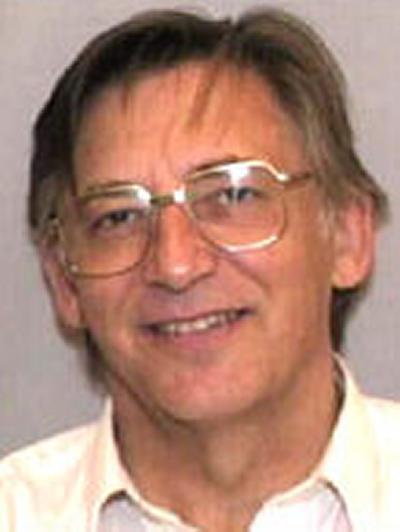Anthony, C. (2011). How half a century of research was required to understand bacterial growth on C1 and C2 compounds; the story of the serine cycle and the ethylmalonyl-CoA pathway. Science Progress, 94, 109-137.
Anthony, C. (2008) A tribute to Howard Dalton and methane monooxygenase. Science Progress, 91, 401-415.
Paul Williams, Leighton Coates, Fiyaz Mohammed, Raj Gill Peter Erskine, Dominique Bourgeois, Steve P. Wood, Chris Anthony and Jonathan B. Cooper* (2006). The 1.6 A° X-ray Structure of the Unusual c-type Cytochrome, Cytochrome cL, from the Methylotrophic Bacterium Methylobacterium extorquens. J. Mol. Biol. 357, 151–162
P A Williams, L Coates, F Mohammed, R Gill, P T Erskine, A Coker, S P Wood, C Anthony, J B Cooper (2005) . The atomic resolution structure of methanol dehydrogenase from Methylobacterium extorquens. Acta Crystallogr D Biol Crystallogr. 61:75-9
Felton, L. M. & Anthony, C. (2005). Role of PQQ as a mammalian enzyme cofactor? Nature doi:10.1038/nature03322
DP Kelly, C Anthony, JC Murrell (2005) . Insights into the obligate methylotroph Methylococcus capsulatus. Trends in Microbiology 13, 195-198.
Anthony, C. (2004). The quinoprotein dehydrogenases for methanol and glucose. Archiv. Biochem. Biophys . 428 , 2-9.
Anthony, C. (2004) The Pyrroloquinoline Quinone (PQQ)-Containing Dehydrogenases. In Zannoni D. (ed): Respiration in Archaea and Bacteria. Vol. 1. Diversity of Prokaryotic Electron Transport Carriers, pp. 203-225. Kluwer Academic Publishers. Printed in The Netherlands.
Anthony, C. and Williams, P.W. (2003). The structure and function of methanol dehydrogenase. Biochim. Biophys. Acta 1467, 18-23
James, P.L. and Anthony, C. (2003). The metal ion in the active site of the membrane glucose dehydrogenase of Escherichia coli . Biochim. Biophys. Acta 1467, 200-205.
Toyama , H., Inagaki, H., Migita, T., Matsushita, K., Anthony, C. and Adachi, O. (2003).The role of the MxaD protein in the respiratory chain of Methylobacterium extorquens during growth on methanol. Biochim. Biophys. Acta 1467, 372-375.
Anthony, C., John, R.A, and Wilmot, C.M. (Eds) (2003). Special Issue: 3 rd International Symposium on Vitamin B 6 , PQQ, Carbonyl catalysis and Quinoproteins. Biochim. Biophys. Acta 1647, 1-408.
Afolabi, P.R. Mohammed, F., Amaratunga, K., Majekodunmi, O., Dales, S.L., Gill, R., Thompson, D., Cooper, J.B., Wood, S.P., Goodwin, P.M. and Anthony, C. (2001). Site-directed mutagenesis and X-ray crystallography of the PQQ-containing quinoprotein methanol dehydrogenase and its electron acceptor cytochrome c. Biochemistry 40, 9799-9809.
Anthony, C. (2001). Pyrroloquinoline quinone (PQQ) and quinoprotein enzymes. Antioxidants and Redox signalling 3, 757-774.
Anthony, C. (2000). Methanol dehydrogenase; a PQQ-containing quinoprotein dehydrogenase. In Enzyme-catalysed electron and radical transfers. Subcellular Biochemistry 35, 273-118.
Cozier, G.E., Salleh, R.A. & Anthony, C. (1999). Characterisation of the membrane glucose dehydrogenase from Escherichia coli and characterisation of a site directed mutant in which His262 has been changed to tyrosine. Biochem. J. 340, 639-647.
Anthony, C. & Ghosh, M. (1998). The structure and function of the PQQ-containing quinoprotein dehydrogenases. Progress in Biophysics and Molecular Biology 69, 1-21.
Anthony, C. (1998). Quinoprotein-catalysed reactions. In Comprehensive Biological Catalysis, Academic Press (Ed, M. Sinnott), 155-180.
Goodwin, P.M. & Anthony, C. (1998). The biochemistry, physiology and genetics of PQQ and PQQ-containing enzymes. Advances in Microbial Physiology 40, 1-80.
Read, J., Gill, R., Dales, S. D., Cooper, J.B., Wood, S.P. & Anthony, C. (1999). The molecular structure of an unusual cytochrome c 2 determined at 2.0 ? ; the cytochrome c H from Methylobacterium extorquens. Protein Science 8, 1232-1240
Toyama H., Anthony, C. & Lidstrom, M.E. (1998). Construction of insertion and deletion mxa mutants of Methylobacterium extorquens AM1 by electroporation. FEMS Microbiol. Letts. 166, 1-7.
Amaratunga, K., Goodwin, P.M., O'Connor, C.D. & Anthony, C. (1997). The methanol oxidation genes mxaFJGIR(S)ACKLD in Methylobacterium extorquens. FEMS Microbiol. Lett. 146, 31-38.
Anthony, C. (1996). Quinoprotein-catalysed reactions. Biochem.J. 320, 697-711.
Anthony, C. and Ghosh, M. (1996). The structure and function of PQQ-containing quinoproteins. Current Science ( India ) 72, 716-727.
Goodwin, M.G. & Anthony, C. (1996). Characterisation of a novel methanol dehydrogenase containing a Ba 2+ ion at the active site. Biochem. J. 318, 673-679.
Goodwin, M.G., Avezoux, A., Dales, S.L. & Anthony, C. (1996). Reconstitution of the quinoprotein methanol dehydrogenase from active Ca 2+ -free enzyme with Ca 2+ , Sr 2+ or Ba 2+ . Biochem. J. 319, 839-842.
Avezoux, A., Goodwin, M.G. & Anthony, C. (1995). The role of the novel disulphide ring in the active site of the quinoprotein methanol dehydrogenase from Methylobacterium extorquens. Biochemical Journal 307, 735-741.
Cozier, G.E., Giles, I.G. & Anthony, C. (1995). The structure of the quinoprotein alcohol dehydrogenase of Acetobacter aceti modelled on that of methanol dehydrogenase from Methylobacterium extorquens. Biochemical Journal 308, 375-379.
Dales, S.L. & Anthony, C. (1995). The interaction of methanol dehydrogenase and its cytochrome electron acceptor. Biochem. J. 312, 261-265.
Ghosh, M., Anthony, C., Harlos, K., Goodwin, M.G. & Blake, C.C.F. (1995). The refined structure of the quinoprotein methanol dehydrogenase from Methylobacterium extorquens at 1.94Å. Structure 3, 177-187.
